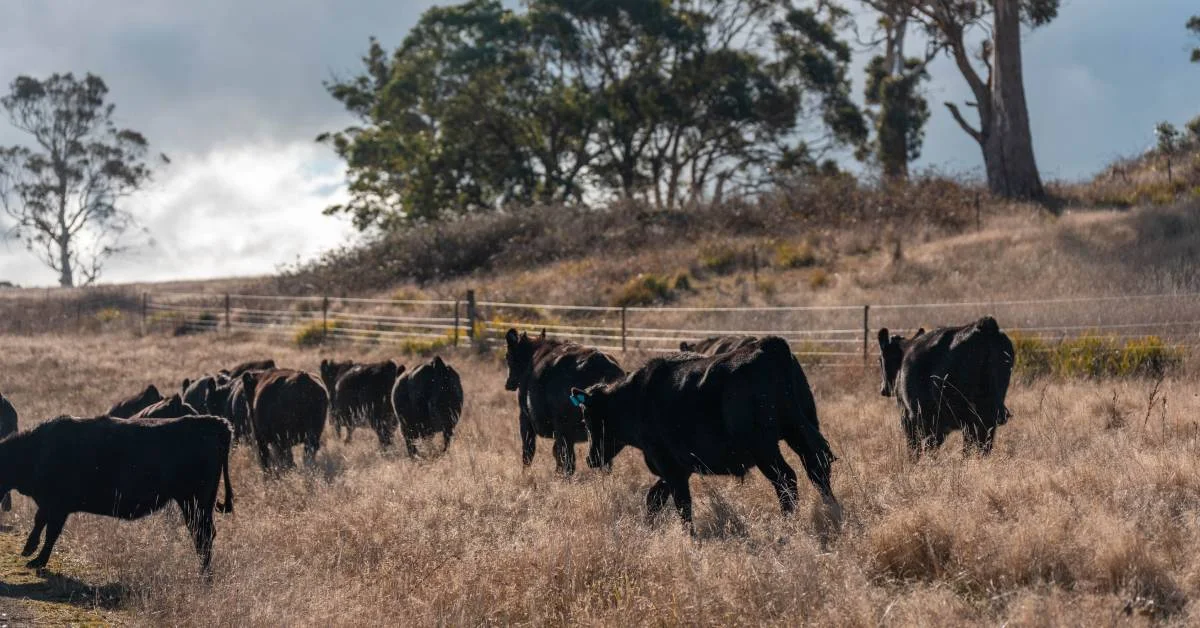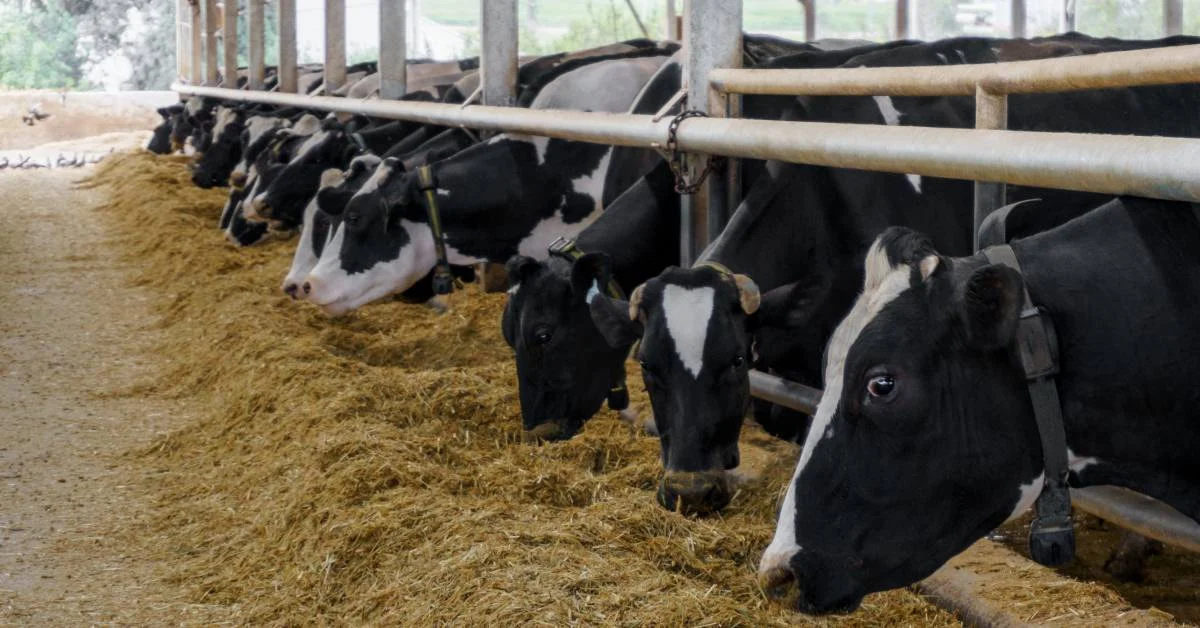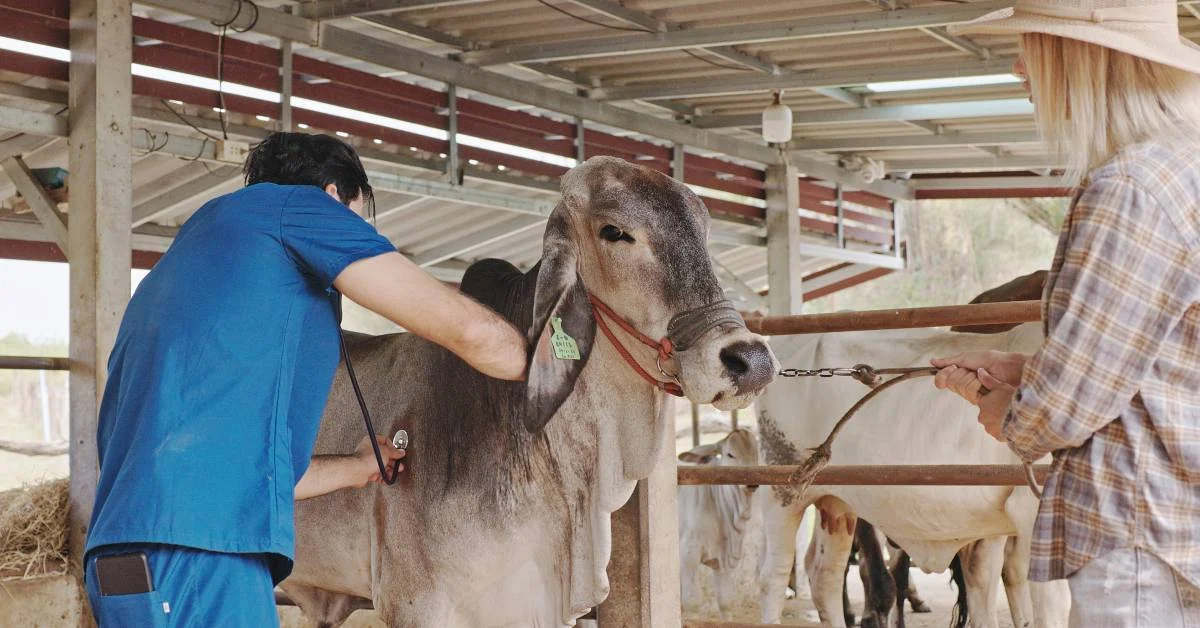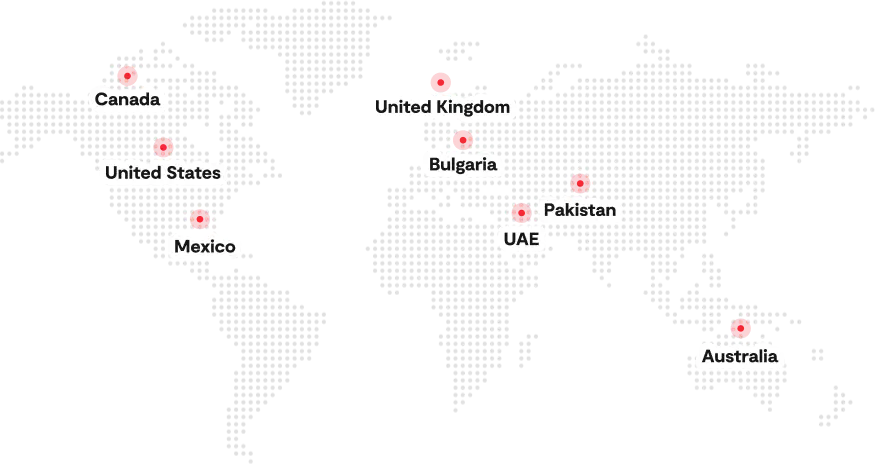Roughly 14% of food is lost globally before it reaches the consumer, with much of it disappearing due to inefficiencies in the supply chain, according to FAO. For agribusinesses, this translates into more than just waste. It means compliance failures, contract penalties, and shrinking profit margins.
Traditional agricultural supply chains lack end-to-end visibility, making it difficult to track product movement, monitor quality, or respond to disruptions. This is particularly risky for perishable goods, where delays or temperature fluctuations can quickly lead to spoilage and lost revenue.
Modern agricultural supply chain tracking addresses these challenges by providing real-time visibility, traceability, and control across every stage from field to shelf. Using technologies like smart labels, RFID, GPS, and IoT sensors, agribusinesses can monitor environmental conditions, trace product origins, and flag issues before they impact food quality or delivery timelines.
In today’s market, where regulatory scrutiny is rising and consumers demand transparency, digitizing the supply chain is no longer optional. This blog breaks down how supply chain tracking in agriculture works, what technologies power it, and why it’s a strategic investment for growers, processors, and supply chain leaders.
What is Supply Chain Tracking in Agriculture?
Supply chain tracking is the process of monitoring the flow of goods through each stage of the supply chain from raw materials to finished food products. In agriculture, this tracking ensures that every input and output is documented, measured, and traceable, helping mitigate risks related to food safety, loss, and operational inefficiencies.
It becomes especially critical in perishable goods supply chains, where even slight delays or temperature deviations can lead to spoilage and revenue loss. According to a study, seven key technologies — such as IoT and RFID, 5G, big data, blockchain, digital twins, and intelligent autonomous systems — are recognized as central enablers of enhanced visibility, control, and resilience in supply chain management.
Modern agricultural supply chain tracking relies on a combination of advanced agriculture technologies to provide real-time visibility and transparency. These include:
- IoT sensors collect data on environmental conditions, such as temperature and humidity.
- RFID (Radio Frequency Identification) tags for non-intrusive product identification and tracking of movement.
- Blockchain provides secure and tamper-proof records for traceability.
- GPS, which tracks transport routes and delivery timelines with precision.
How Agricultural Supply Chain Tracking Works?
In practice, agricultural supply chain tracking begins at the farm. IoT-enabled devices monitor the growing environment, including soil moisture, air temperature, and light levels, to ensure optimal crop health and growth. As products are harvested, RFID tags and smart labels are applied to record their origin, quality, and handling conditions. These tags continue to transmit data through storage, processing, and transport phases, enabling full traceability and minimizing human error.
This end-to-end visibility is especially effective when paired with specialized software designed for agriculture’s unique demands. For example, Folio3 AgTech supply chain management software offers a connected digital ecosystem that tracks every load, contract, and inventory movement across multiple farm-to-market points, eliminating the need for manual check-ins.
Its features, such as real-time inventory management, procurement scheduling, and lot-level batch tracking, are specifically tailored to meet the dynamic needs of the agricultural industry. For supply chain managers and agribusiness owners, these capabilities translate into more precise demand forecasting, improved grower coordination, and reduced product loss, all critical factors in a market where timing and traceability directly impact profitability.
With the integration of these digital tools and automated tracking systems, supply chain tracking in agriculture empowers stakeholders to move beyond reactive decisions and adopt a proactive, data-informed approach to logistics. For those evaluating digital transformation solutions, understanding how these technologies work and what platforms support them is key to building a more reliable and responsive supply chain.
Key Technologies in Agricultural Supply Chain Tracking
Effective supply chain tracking in agriculture relies on the smart use of digital technologies that capture, transmit, and analyze data throughout the farm-to-market journey. These tools not only enhance visibility but also help reduce losses, improve compliance, and support more informed decision-making throughout the entire supply chain.
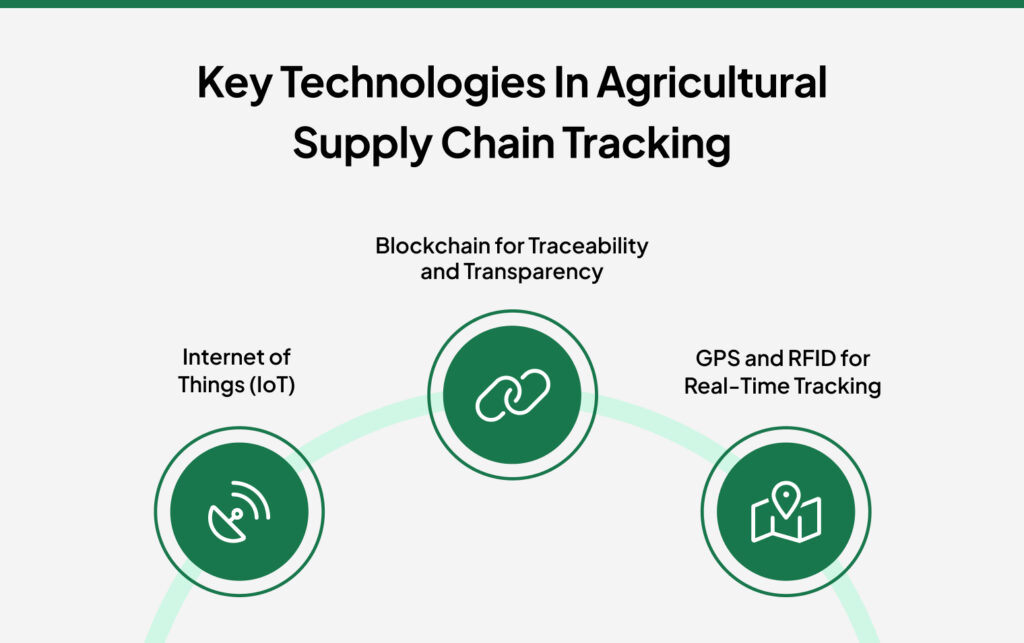
1. Internet of Things (IoT)
IoT sensors have become a core component of agricultural supply chain tracking, offering real-time monitoring of environmental and operational conditions. Deployed in fields, cold storage units, processing plants, and trucks, these sensors measure variables such as temperature, humidity, light exposure, and location.
For perishable goods, maintaining consistent conditions is crucial. Sudden changes in temperature during transport or storage can compromise food quality and safety. With IoT, supply chain managers receive instant alerts when thresholds are breached, enabling them to take immediate action.
Additionally, IoT-enabled equipment monitoring can reveal early signs of wear or malfunction, supporting predictive maintenance strategies that minimize downtime and prevent spoilage.
2. Blockchain for Traceability and Transparency
Blockchain technology offers a secure and tamper-proof ledger for recording each transaction or movement within the agricultural supply chain. From the origin of raw materials to processing, packaging, and delivery, every step can be timestamped and validated. This immutability creates a reliable record that strengthens food traceability, mitigates fraud, and supports compliance with regulatory requirements such as FSMA and HACCP.
According to McKinsey, adopting digital technologies in supply chains, “Supply Chain 4.0”, can reduce operational costs by up to 30% and cut lost sales by as much as 75%. For agribusinesses aiming to deliver transparency from farm to table, blockchain is quickly becoming a strategic necessity.
3. GPS and RFID for Real-Time Tracking
The Global Positioning System (GPS) technology enables logistics managers to track agricultural shipments in real-time. This level of oversight helps optimize delivery routes, prevent delays, and reduce fuel costs. In agriculture, where freshness and timing are critical, live GPS data ensures that products reach their destination within the acceptable quality window.
Meanwhile, RFID (Radio Frequency Identification) tags are used to monitor product movements across warehouses, processing units, and transit vehicles. By scanning RFID tags, teams can maintain accurate inventory records, reduce manual entry errors, and avoid losses due to misplacement or spoilage.
We have integrated these technologies into our supply chain management software to offer GPS-enabled load visibility and RFID-based lot tracking, connecting farm operations, packhouses, and cold storage in a unified digital system. For organizations comparing technology partners, this level of interoperability is crucial for building a reliable and future-ready supply chain.
Benefits of Supply Chain Tracking in Agriculture
Implementing supply chain tracking in agriculture is more than a digital upgrade. It’s a strategic shift toward resilience, transparency, and smarter operations. Below are the key benefits that agricultural businesses, co-ops, and investors can expect when adopting modern tracking technologies and practices.
Improved Efficiency and Reduced Costs
Agricultural supply chains often stretch across remote growing regions, regional packhouses, and export terminals, making coordination complex and error-prone. Supply chain tracking helps eliminate inefficiencies caused by manual logbooks, missed harvest pickups, or overstocked cold storage units.
With automated load scheduling, harvest batch visibility, and smart inventory rotation, farm managers and distributors can optimize labor use and reduce spoilage. For example, solutions like Folio3 AgTech Supply Chain Management Software enable real-time updates from field to packhouse, minimizing post-harvest losses and transportation delays, especially for short-shelf-life crops like berries or leafy greens.
Enhanced Traceability and Transparency
Agricultural traceability is no longer a “nice-to-have.” Compliance with standards like FSMA, HACCP, and GlobalG.A.P. demands end-to-end visibility across input sourcing, pesticide application, and cold chain custody.
Digital tools like RFID tagging of produce crates, blockchain-based lot tracking, and IoT-enabled cold storage monitoring give agribusinesses and cooperatives the ability to verify crop origin, farm practices, and storage conditions. This level of transparency not only streamlines third-party audits but also builds resilience against product recalls or contamination claims.
Better Decision-Making with Real-Time Data
From fluctuating weather patterns to unpredictable commodity prices, farming is a real-time business. Supply chain tracking systems provide field-to-fork data continuity, allowing producers to align planting, harvesting, and delivery with shifting market demands or climate realities.
Using GPS-enabled fleet tracking and IoT temperature sensors, for instance, packhouses can redirect shipments of ripening produce or adjust reefer settings mid-transit to prevent heat damage. This data-driven responsiveness is especially valuable in managing exports of sensitive crops like mangoes, cherries, or cut flowers.
Increased Consumer Confidence and Marketability
Retailers and end-consumers increasingly demand proof of provenance, especially in organic, non-GMO, or sustainably farmed products. Supply chain tracking enables producers to validate these claims with digital records, down to the field block, input application, and harvest date.
By integrating GS1 QR codes or digital certification logs with each shipment, agribusinesses can offer buyers and consumers transparency around food origin, ethical sourcing, and safety compliance. This not only builds trust but also creates differentiation in competitive global markets.
Future-Proofing Against Supply Chain Disruptions
Agriculture is uniquely vulnerable to external shocks, be it a sudden pest outbreak, a border closure, or an input supply delay during planting season. A digitized, trackable supply chain helps businesses anticipate bottlenecks and reroute operations without major disruptions.
Tools like multi-site inventory visibility, supplier risk scoring, and demand planning dashboards allow supply chain managers to respond proactively, whether they’re dealing with delayed fertilizer shipments or rerouting a cold chain due to port congestion.
How Folio3 AgTech’s Agricultural Supply Chain Management Software Can Help
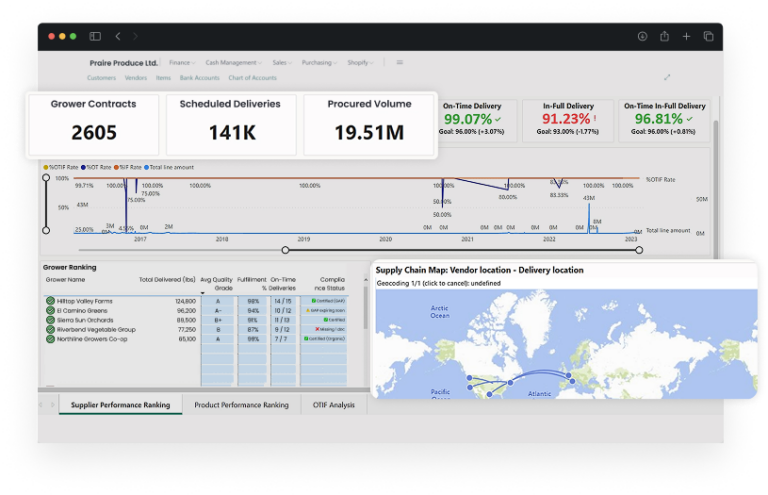
In an industry where every decision from procurement to shipment affects both margins and food quality, having complete visibility across the supply chain is no longer a luxury. It’s a necessity—businesses with digital supply chain solutions experience improvement in operational efficiency. Yet, many agricultural enterprises still rely on outdated manual methods or disconnected software systems.
Folio3 AgTech agricultre ERP solution can offer a meaningful impact, not as a one-size-fits-all tool, but as a tailored platform built around the real-world needs of growers, processors, distributors, and cooperatives.
What sets this system apart is its focus on end-to-end operational continuity, capturing data, reducing waste, and facilitating smooth collaboration among teams without the usual back-and-forth delays. For example:
- Demand Forecasting & Planning: This enables agribusinesses to align planting and procurement with market demand and buyer contracts, thereby avoiding both oversupply and stockouts.
- Real-Time Inventory Tracking: It enables managers to monitor stock levels across silos, cold storage, and packhouses with live status updates, reducing spoilage and logistics gaps.
- Grower Contract Management: Centralizes agreements and delivery terms, facilitating easier compliance and reducing costly miscommunications.
- Multi-Location Load Visibility: Provides stakeholders with the ability to track inbound and outbound movements across farms, storage hubs, and transportation in real-time.
Where many platforms treat agricultural logistics as a subcategory of general supply chain management, supply chain software by Folio3 AgTech is purpose-built for the unique seasonal, geographical, and biological complexities of the agricultural sector. It doesn’t just digitize processes, it connects them in a way that reflects how agriculture works.
For decision-makers comparing options in the mid-evaluation stage, the software offers both modularity and depth: you can start with a few key workflows, such as procurement tracking or lot traceability, and then scale as your operational needs grow.
Conclusion
As global food systems become more complex and consumer expectations for transparency rise, supply chain tracking in agriculture is no longer optional, but it’s strategic. From improving efficiency and cutting operational costs to enhancing traceability and building trust with buyers, modern supply chain tracking solutions empower agricultural businesses to compete in a data-driven world.
Folio3 AgTech Supply Chain Management Software offers a connected, purpose-built framework to track every load, contract, and input from farm to market, eliminating guesswork and enabling smarter, more agile operations. For agricultural leaders evaluating technologies to strengthen their supply chain, now is the time to explore tools that offer both immediate operational clarity and long-term scalability.
FAQs
What Is Supply Chain Tracking In Agriculture, And How Does It Work?
Supply chain tracking in agriculture refers to the monitoring of goods flow from farm to market, utilizing tools such as IoT, GPS, and RFID for real-time data and traceability.
How Does Supply Chain Tracking Benefit Agricultural Businesses?
It improves efficiency, reduces losses, ensures product traceability, and supports smarter decision-making with real-time supply chain insights.
What Technologies Are Used For Supply Chain Tracking In Agriculture?
Technologies include IoT sensors, GPS, RFID tags, and blockchain, all of which enable transparency, live tracking, and data-driven management of the agricultural supply chain.
How Does Supply Chain Tracking Improve Food Safety In Agriculture?
It enhances food safety by providing traceability of every product batch, helping identify contamination sources quickly, and ensuring regulatory compliance.
Can Folio3 AgTech Help Integrate Supply Chain Tracking Into My Agricultural Business?
Yes, Folio3 AgTech offers agriculture-specific supply chain tracking software designed to streamline operations and deliver real-time visibility across your value chain.


